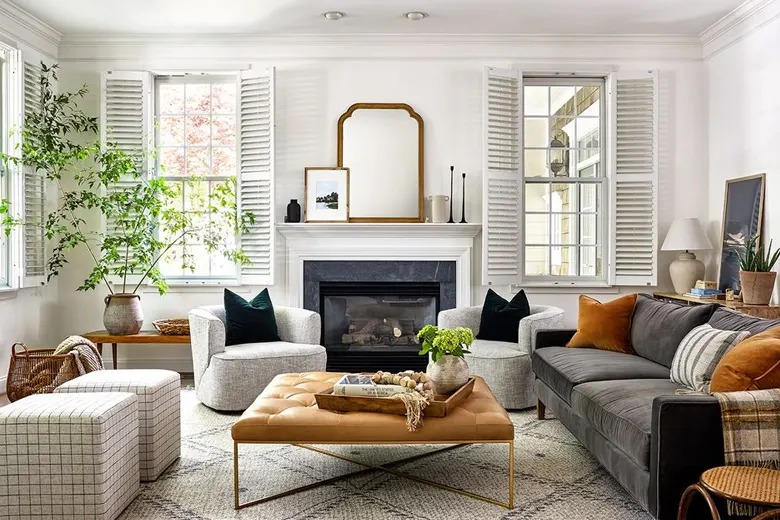Envisioning your space before diving into the decorating process is essential to creating a cohesive, functional, and aesthetically pleasing environment. It helps you avoid impulsive decisions that may lead to cluttered or mismatched designs. Here’s how you can envision your space effectively:
1. Start with the Function
The first step is to think about how the space will be used. This is especially important for multifunctional spaces like living rooms, kitchens, or home offices. Ask yourself:
- What activities will take place in this room? (e.g., dining, relaxing, working, entertaining)
- How many people will be using the space?
- What is the flow of traffic in the room?
This will inform your furniture choices, layout, and the overall style of the room.
2. Assess the Space’s Natural Characteristics
Take time to study the room you’re designing. Consider:
- The shape of the room: Is it rectangular, square, or oddly shaped? The layout of your furniture will depend on this.
- Lighting: Is there plenty of natural light from windows, or does it feel dark? A sunny room might benefit from lighter colors, while a room with less natural light could use lighter furniture or mirrors to brighten things up.
- Architectural features: Take note of any exposed beams, fireplaces, windows, or built-in features. These can be key focal points that you want to emphasize or complement.
- Size and Scale: Think about the room’s size and the scale of the furniture you’ll be using. Oversized furniture in a small room can make the space feel cramped, while too-small pieces in a large room can look out of place.
3. Consider Your Style Preferences
Before purchasing furniture and décor, it’s important to get clear on the overall style you want to achieve. You can either stick to one specific style or blend different influences. Consider:
- Mood or vibe: Do you want a cozy, laid-back feel? A sleek, modern look? Or a bold, eclectic design? Understanding the vibe will help you narrow down choices for colors, furniture, and accessories.
- Inspirational images: Browse Pinterest, Instagram, or magazines to create a mood board with images of spaces you admire. This helps to visualize the overall aesthetic and serves as a reference when you start buying items.
4. Define Color Schemes and Textures
Colors can drastically affect the mood of a room. Envision how the colors will work together, considering the tones of furniture, walls, and accents:
- Palette: Do you want a neutral palette for a calming effect, or are you drawn to bold, vibrant colors for a more dynamic look?
- Textures: Think about mixing and matching textures (like smooth leather with soft wool or sleek metal with rough wood) to create visual and tactile interest in the room.
5. Create a Floor Plan
Before moving furniture around, try creating a floor plan of the space. You can use online tools or simply draw it out on paper. This helps you:
- Visualize layout: Determine where furniture will go and ensure there’s enough space for walking and interaction. Think about creating conversation areas, placing furniture near windows for natural light, or arranging pieces for easy TV viewing.
- Experiment: Try different layouts in your mind or on paper until you find one that feels balanced and functional. Don’t be afraid to experiment!
6. Think About Practicality
Envision not just how the space will look, but how it will function day-to-day. Consider:
- Storage needs: Will the room need extra storage? Think about furniture pieces that serve double duty, like storage ottomans or multi-purpose coffee tables.
- Comfort: Think about how comfortable the space will be. For example, are the seating options cozy enough for lounging? Is there sufficient lighting for reading or working?
- Maintenance: Consider ease of cleaning when choosing furniture and materials. Dark colors can be stylish, but they may show dust and dirt more than lighter options.
7. Scale Your Furniture and Decor
To avoid overcrowding or underfurnishing the space, it’s essential to envision how each item will fit:
- Furniture size: Larger rooms can handle oversized furniture, while smaller rooms may benefit from more compact, multi-functional pieces.
- Spacing: Make sure there’s enough room for people to move around. Create walkways that are at least 2-3 feet wide, and allow for a comfortable amount of space between furniture pieces.
8. Focus on Focal Points
Every room should have a focal point, something that draws attention when you walk in. Some examples include:
- Artwork or decor: A statement piece of art or a unique sculpture can be the centerpiece of a room.
- Furniture: A striking sofa or vintage coffee table can set the tone.
- Architectural features: A fireplace, a large window, or exposed beams can serve as the room’s natural focal point.
Make sure your layout and furniture choices highlight this feature, creating balance and flow in the room.
9. Create a Budget and Timeline
Setting a budget can help keep your design plans grounded in reality. Break down how much you’re willing to spend on furniture, decor, and any necessary renovations. Having a timeline will also help you pace the process, so you don’t feel rushed or overwhelmed.
10. Visualize the Entire Space
Don’t just focus on one corner or one piece of furniture. Step back and imagine how the room will feel as a whole. Does it flow well from one area to another? Do the colors, textures, and furniture pieces work together? Try to imagine how you will use the room day-to-day to ensure that it feels both functional and beautiful.
Conclusion
Envisioning your space before you start decorating helps ensure that everything comes together seamlessly. By considering function, lighting, colors, textures, and practical needs, you can design a room that is not only visually appealing but also enjoyable to live in. Take the time to plan and reflect, and you’ll find that the process becomes more enjoyable and efficient!

